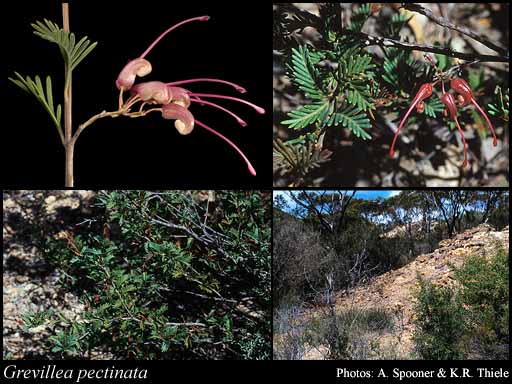- Reference
- Prodr. Suppl. 23 (1830)
- Conservation Code
- Not threatened
- Naturalised Status
- Native to Western Australia
- Name Status
- Current
Spreading, ?lignotuberous shrub, 0.5-2 m high, up to 2.5 m wide. Fl. red/pink & cream, Jun or Sep to Dec or Jan. Sandy or clayey soils over laterite.

Scientific Description
Shrubs, 1.5-2.5 m high; branchlets hairy, not glaucous. Leaves alternate, 15-60 mm long, 6-20 mm wide, hairy or glabrous, on the adaxial or abaxial surface, the hairs straight; lamina flat, clearly widest above the middle, once divided, pinnately divided or divided only at the apex, shallowly divided or divided to the midrib; lobes 5-20 mm long, 0.5-2 mm wide, the margins recurved or revolute, enclosing the lower surface of the leaf blade, forming a groove either side of the midvein. Inflorescences terminal, red or pink; pedicels 5-8 mm long. Perianth 14-18 mm long; tepals some joined and some free after flower opens, hairy, glandular-hairy; ovary glabrous, stipitate, the stipe 1.5-2.5 mm long; pistil 25-35 mm long, red or pink, pollen presenter lateral or oblique, style glabrous. Follicles glabrous, not viscid, dehiscent, 8-11 mm long. Flowers in January, June, July, August, September, October, November or December. Occurs in the South-west (SW) Botanical Province(s), in the Jarrah Forest (JF), Mallee (MAL) or Esperance Plains (ESP) IBRA subregion(s).
Distribution
- IBRA Regions
- Esperance Plains, Mallee.
- IBRA Subregions
- Eastern Mallee, Fitzgerald, Recherche, Western Mallee.
- IMCRA Regions
- WA South Coast.
- Local Government Areas (LGAs)
- Albany, Esperance, Gnowangerup, Jerramungup, Kent, Kulin, Lake Grace, Ravensthorpe.